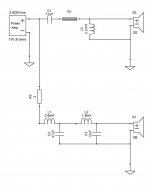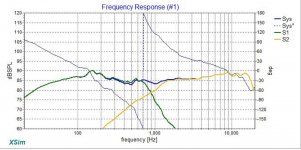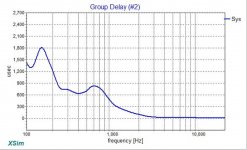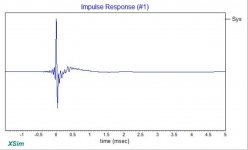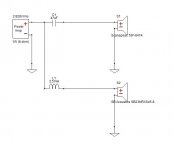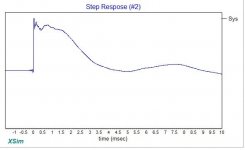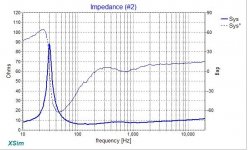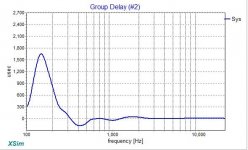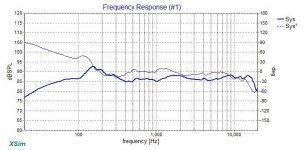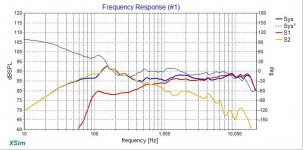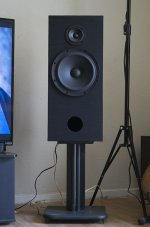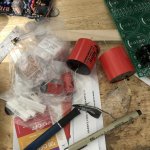Thanks, X.
hope you had a good 4th of July.
I had already tried a 4mH inductor in XSim and it has a very minimal effect on the woofer. It lowers it by -3dB at 1kHz, and about -5dB at 10kHz from its original dropping response. That's an expensive inductor for such a small effect.
I'll try a 50-ish uF cap (thanks for the tip on cheap electronics) on the sealed b80, and stick with the 20uF for the one on OB.
hope you had a good 4th of July.
I had already tried a 4mH inductor in XSim and it has a very minimal effect on the woofer. It lowers it by -3dB at 1kHz, and about -5dB at 10kHz from its original dropping response. That's an expensive inductor for such a small effect.
I'll try a 50-ish uF cap (thanks for the tip on cheap electronics) on the sealed b80, and stick with the 20uF for the one on OB.
One more thing...
Me, being so clueless about electricity...
Do you see a problem using a 8 Ohms, 20W ceramic resistor across the terminals of the woofer to bring the whole system impedance down?
I'm not using a tiny D board.
My amp is rated at 210W per channel. I rarely listen to music above 83dBs, so I am not using all those 210W !
Me, being so clueless about electricity...
Do you see a problem using a 8 Ohms, 20W ceramic resistor across the terminals of the woofer to bring the whole system impedance down?
I'm not using a tiny D board.
My amp is rated at 210W per channel. I rarely listen to music above 83dBs, so I am not using all those 210W !
You are turning the load presented to the amp as a 4ohm load. As long as it is stable into 4 ohms that is fine. Are you trying to reduce the power going to the woofer?
The amp is stable down to 3 Ohms, and lower if not pushed too hard.
No, I'm running the woofer free, as it is only 84dB and need all the power it can produce.
I was trying to make the total system impedance flatter, in case someone with a tube amp would like to try them. Solid State amps should have no problem with the original impedance peaks, but I was led to believe tube amps like a flatter impedance response.
No, I'm running the woofer free, as it is only 84dB and need all the power it can produce.
I was trying to make the total system impedance flatter, in case someone with a tube amp would like to try them. Solid State amps should have no problem with the original impedance peaks, but I was led to believe tube amps like a flatter impedance response.
Hi
so what do you think ? 😀 couldn't achieve TP or Harsch. suggestions ?
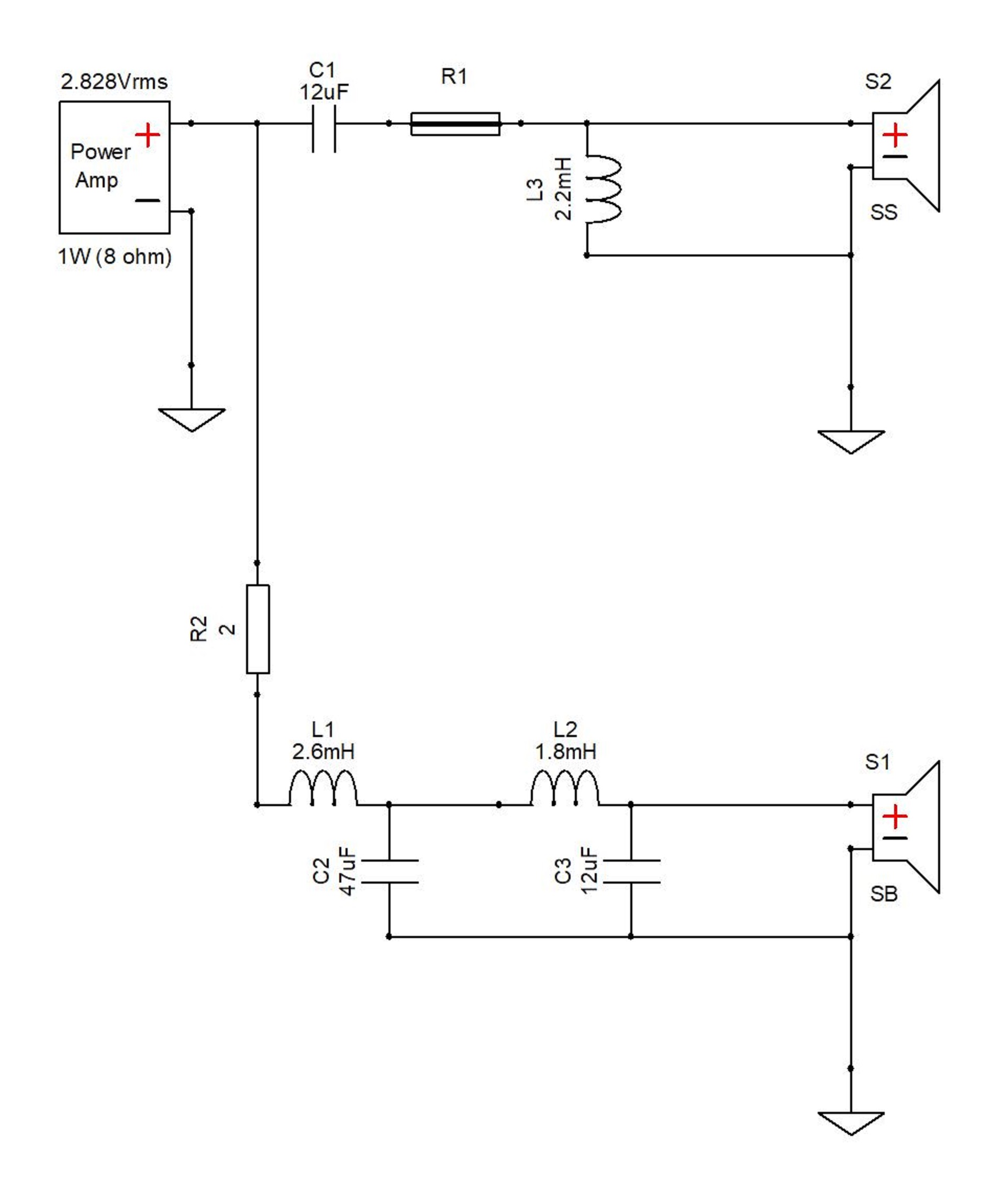
so what do you think ? 😀 couldn't achieve TP or Harsch. suggestions ?
Attachments
Last edited:
I would make the XO frequency lower for a FAST and it also relaxes requirements for CTC spacing of tweeter to woofer as that needs to be less than 1/3rd wavelength at XO frequency. It looks like you have a 4th order low pass on the woofer. You want first order and add a notch with RC across the terminals to kill off any cone breakup at higher frequencies by still keep slope 1st order. That’s the 4.4uF and 0.47R strapped across woofer on mine. Woofer should only have that notch and a large inductor maybe circa 4mH to keep it first order.
On tweeter have only cap no inductor to ground as that makes it 2nd order. Pad (attenuate) the tweeter with R until it level matches woofer. You will need to manually add spatial delay of maybe 1in to 3in to tweeter (right click on tweeter dialog) to get phase to match and prevent dip/notches near XO frequency.
Start with my published XO and go from there.
What you have here is a far far away from TP (must be 1st order). Don’t bother doing Harsch with passive as you can’t provide the huge time delay (0.5ms) needed unless you move tweeter 5.5in backwards. Although that’s doable if you flip speaker so tweeer is on bottom and lean box so woofer is forward a few inches. Looks ugly that way.
On tweeter have only cap no inductor to ground as that makes it 2nd order. Pad (attenuate) the tweeter with R until it level matches woofer. You will need to manually add spatial delay of maybe 1in to 3in to tweeter (right click on tweeter dialog) to get phase to match and prevent dip/notches near XO frequency.
Start with my published XO and go from there.
What you have here is a far far away from TP (must be 1st order). Don’t bother doing Harsch with passive as you can’t provide the huge time delay (0.5ms) needed unless you move tweeter 5.5in backwards. Although that’s doable if you flip speaker so tweeer is on bottom and lean box so woofer is forward a few inches. Looks ugly that way.
Thanks for the reply X, what do you think ? i added the notch filter but it did not had a huge effect on cone break up, woofer probably behave ?
also does not look like it need a resistor at tweeter, i was thinking maybe add a small one to woofer to make the tweeter a little brighter.
Not sure about that 150Hz peak, tried to calculate a notch there and it looks like it works but it has some crazy cap value.

also does not look like it need a resistor at tweeter, i was thinking maybe add a small one to woofer to make the tweeter a little brighter.
Not sure about that 150Hz peak, tried to calculate a notch there and it looks like it works but it has some crazy cap value.
Attachments
Nice work! That’s a pretty good step response. Is the woofer response measured in your box or factory curve? Usually, factory one is on a large flat open baffle so doesn’t have baffle step loss of 4-5dB. 10F is 87dB driver and SB is 89dB driver so will be about 85dB after baffle step. You may need mild -2dB padding on 10F. Probably 4ohms in series. Can you show the S1 and S2 woofer and tweeter curve so I can see where XO is? The phase plot is is very flat so probably good. Don’t worry about 150Hz bump. In a real speaker there is a 150Hz floor bounce dip so this maybe perfectly suited to cancel that out. You should test it - it doesn’t get simpler than this for a passive XO. I predict it will sound very good.
Did you try moving the speaker around and take new measurements?
150Hz is right smack into room nodes territory.
Edit:
Oh, this exercise is purely rhetorical?
Then, don't XO buy parts until you've made the real boxes and installed the drivers and placed them where they will be listened to. Then, you can fashion a XO around those real world curves.
I was wondering why the SB only goes down to 100+Hz....
150Hz is right smack into room nodes territory.
Edit:
Oh, this exercise is purely rhetorical?
Then, don't XO buy parts until you've made the real boxes and installed the drivers and placed them where they will be listened to. Then, you can fashion a XO around those real world curves.
I was wondering why the SB only goes down to 100+Hz....
Last edited:
Hey and thanks 😀.
The FRDs were provided by Earl and are traced from factory datasheets. the box is already made, this is for my SS/SB FAST speaker i posted while back,I have not simulate this in a box yet.
the XO is at 550Hz, the 10F is in a 0.6 liter cone and large ported cab tuned to 35Hz for woofer.
any suggestions before i buy the parts ? 🙂
Edit : forgot to mention there's also no mod Delay on 10f.
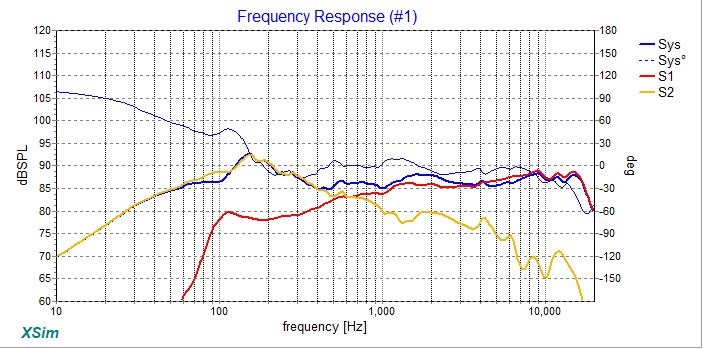
The FRDs were provided by Earl and are traced from factory datasheets. the box is already made, this is for my SS/SB FAST speaker i posted while back,I have not simulate this in a box yet.
the XO is at 550Hz, the 10F is in a 0.6 liter cone and large ported cab tuned to 35Hz for woofer.
any suggestions before i buy the parts ? 🙂
Edit : forgot to mention there's also no mod Delay on 10f.
Attachments
Last edited:
That looks good. Add a 4.7uF film cap in series with 0.47R and whole thing in parallel with woofer terminals. That will pull the 3kHz breakup down another -12dB while leaving the first order XO slope near 500Hz alone. Get the parts - should work with caveat that you flip speaker with woofer on top.
That looks good. Add a 4.7uF film cap in series with 0.47R and whole thing in parallel with woofer terminals. That will pull the 3kHz breakup down another -12dB while leaving the first order XO slope near 500Hz alone. Get the parts - should work with caveat that you flip speaker with woofer on top.
flip the speaker around ? 😕 how can i avoid that ?
flip the speaker around ? 😕 how can i avoid that ?
I think what X meant is that you turn the speaker upside down so that the woofer is on top and the mid-tweet is below the woofer.
Otherwise my understanding is that with the XO that you and X are using, the baffle would have to be "stepped" in order to get transient perfect response.
Btw, I am no expert and hopefully X will chime in soon. 🙂
Zman has it right. It’s to introduce a slight delay that otherwise would have required a 3in stepped baffle. It can work without doing so but the time alignment will not be as good.
Nice premium caps!
not a bad deal if you r looking for some
Audyn Cap Q4 47uF 400V MKP Foil Capacitor | eBay
That’s a great price. Used though. For $13 you can get new ones from PE:
Audyn Cap Q4 47uF 400V MKP Metalized Polypropylene Foil Crossover Capacitor
Audyn Cap Q4 47uF 400V MKP Metalized Polypropylene Foil Crossover Capacitor
How’s the XO coming along Aatto? I just connect with alligator clip jumpers or twist together to do a quick test sometimes. It’s suzh a simple XO that you can do the twist thing easily.
- Home
- Loudspeakers
- Full Range
- 10F/8424 & RS225-8 FAST / WAW Ref Monitor
